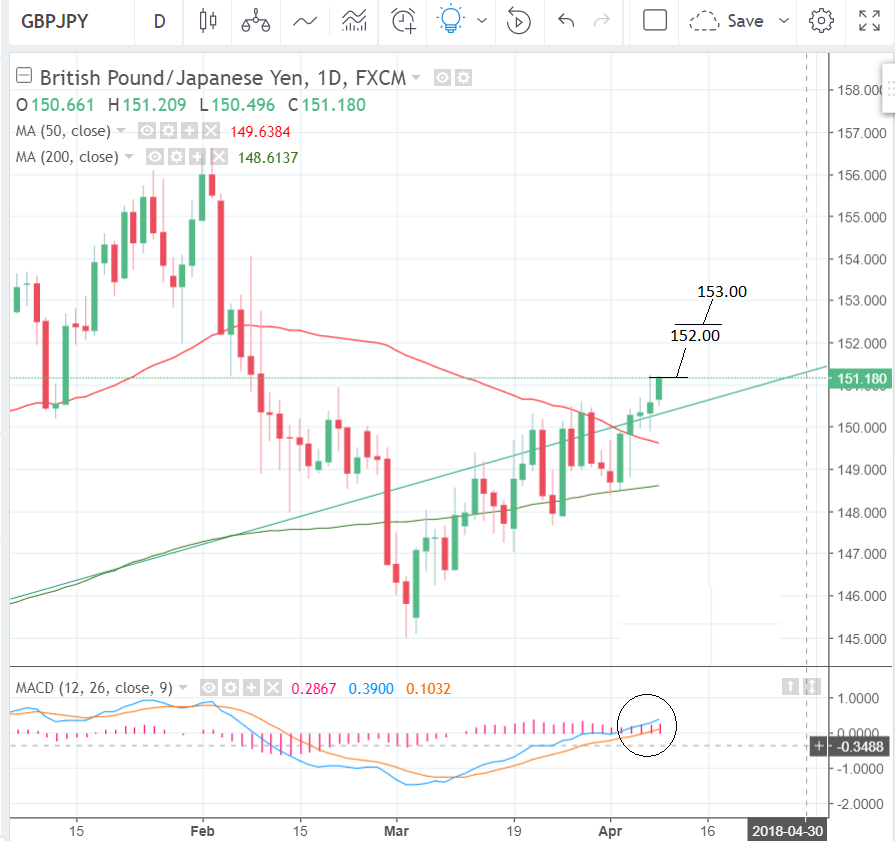Pound-to-Yen Rate Forecast for Week Ahead: More Gains Seen
- GBP/JPY is rising in a strong uptrend which is forecast to continue
- The main release for the Yen in the coming week is Producer Price Inflation
- The Pound will take its cue from Industrial and Maunfacturing production as well as wage data

© DragonImages, Adobe Stock
GBP/JPY is making a striking recovery at the start of the new week with one Pound strengthening to a level where it can buy over 151 Yen on the interbank market.
The Pound-to-Yen exchange rate is rising in a strong uptrend and whilst it is difficult to pinpoint one precise event which sparked the rally, some analysts are speculating strong UK housing data from mortgage lender Halifax was the prime catalyst.
"Sterling rose above two-week lows hit last week after bullish U.K. housing data Monday suggested full steam ahead for the Bank of England to lift lending rates from 0.5% next month," said Joe Manimbo, a senior market analyst at Western Union.
The data showed house prices rose 1.5% in March compared to February, which was well above the 0.1% forecast.
Regardless of short-term phenomenon the move higher conforms to the established uptrend which began back at the March 2 lows at 145.83 (the current exchange rate is 151.48).
From a technical perspective, the exchange rate is looking much more bullish than previously, after having broken back above the major trendline drawn from the October 2016 lows.
We think it likely the short-term trend higher will extend and a break above 151.50 would probably confirm a continuation up to the next target at 152.00, followed by 153.00 conditional on a break above 152.15 (see chart below).
The bullish forecast is supported by rising momentum in the bottom pane, which is reflecting the rising exchange rate (circled).
Data and Events to Watch for the Japanese Yen
A major release out today (Monday) for the Yen was Consumer Confidence which came out at 44.3 in March, which was slightly below the 44.6 forecast.
The Japanese Current Account in February showed a 2.07tr surplus, which was marginally below the 2.16tr forecast but higher than the 0.61tr previously.
The Economy Watcher's Survey in March showed a higher than expected result, 48.9 for 'current situation' but a lower-than-expected 49.6 for 'outlook'.
The next major release is Machine Tool orders at 7.00 on Tuesday, followed by Bank Lending, PPI and Machinery Orders on Wednesday.
PPI, or 'factory gate prices' measures the price of goods as they leave the factory. PPI is forecast to show a -0.1% decline in March compared to February when it rose by 0.0%.
PPI is often a forward indicator of broader inflation, so a poor reading does not bode well for the Bank of Japan's (BOJ) efforts to dislodge endemic low inflation.
Given the BOJ's main strategy for dealing with deflation is via printing money and bond-buying, also known as quantitative easing (QE), and this is negative for the currency, a lower PPI reading will probably weigh on the Yen.
Finally, on Thursday, April 12, at 12.50 data will be released showing the change in the net balance of bond and equity 'trade' in the preceding week.
The Yen may also be moved later on when BOJ governor Kuroda takes the stand and gives a speech at 1.30.
Data and Events to Watch for the Pound
Recent data for the Pound was poor, especially business survey data for March, but the explanation now appears to be that it was all the fault of the weather - the 'Beast from the East' - rather than a real economic slowdown.
This means the Pound is probably on course for more gains as the Bank of England (BOE) are still likely to raise interest rates in May as most expect.
Higher interest rates are the fuel which drives currency trends as international capital-flows now dictate currency values, and they tend to move to places where interest rates are higher, all other things being equal, as that's where they will earn the most return.
Yet notwithstanding the weather, some doubt has now crept into whether the BOE will still pull the trigger in May.
In the coming week, there will be a heavy focus on wage inflation since if that rises the BOE is more likely to want to cool the economy with higher interest rates. In this respect, the IHS Markit REC recruitment industry survey, out at 23.00 GMT on Tuesday, April 9, may be instructive, as it includes the latest pay information from recruiters, according to Chirs Williamson, Chief Economist at IHS Markit.
"With the Bank of England having laid the ground for a May rate hike, the focus will, therefore, fall heavily on pay trends. In that respect, the REC recruitment industry survey will give an update on new starter and temp/contract staff pay rates, both of which tend to move in advance of pay growth in the wider economy," he says.
Another major release in the week ahead is Industrial and Manufacturing Production data for March at 9.30 on Tuesday, and the Trade Balance at the same time, which is forecast to narrow to -11.9bn in February from -12.3bn in the previous month - a narrower trade balance is sometimes positive for currencies, although the correlation of late seems to be waning.
Finally, a heads up for Retails Sales in March comes in the form of the CBI Retail Sales monitor, out at 12.01 on Tuesday.
Get up to 5% more foreign exchange by using a specialist provider to get closer to the real market rate and avoid the gaping spreads charged by your bank when providing currency. Learn more here.


